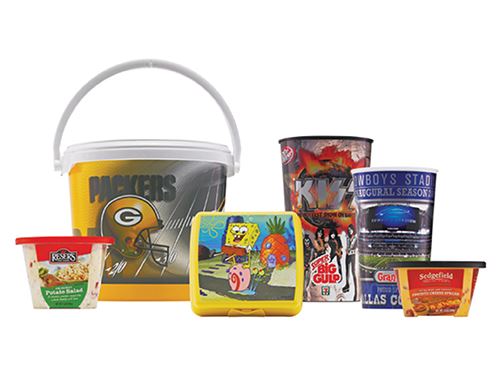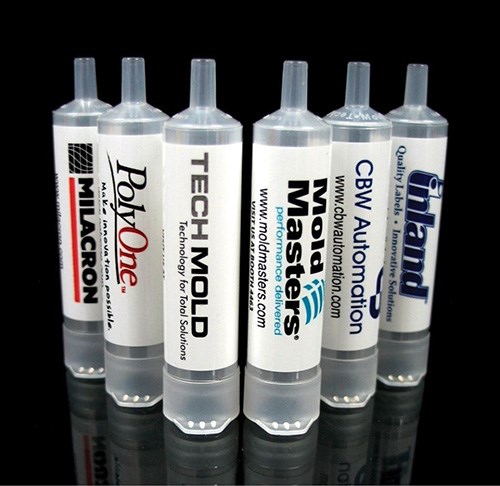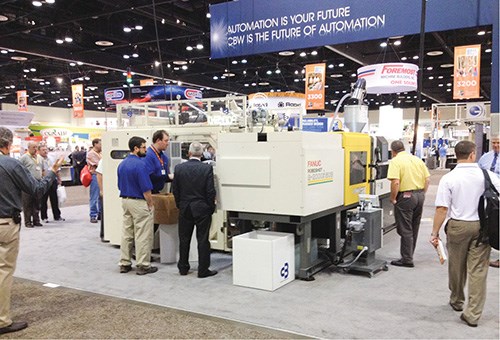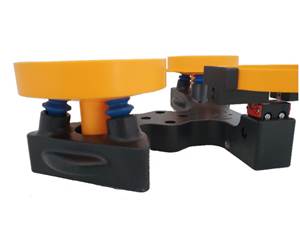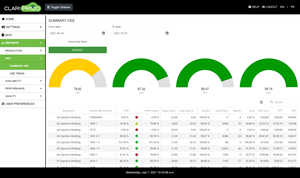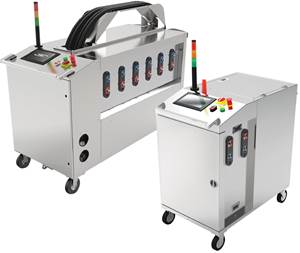Overcoming IML’s Challenges To Reap Its Rewards
tips & Techniques: In-Mold Labeling
In-mold labeling has advanced dramatically over the past 20 years, but mostly in Europe. Here is what you need to know to bring IML to your operation.
In-mold labeling has advanced exponentially over the past two decades for several reasons. It eliminates secondary printing operations that add to the overall manufacturing costs; provides market differentiation in graphics capability; and enhances product security through the use of specialty inks that can provide anti-counterfeiting measures—and because the label is part of the container it cannot be removed and replaced.
While brand owners in Europe have realized the value of IML for more than a decade, the technology has been slower to catch on in North America. There are various reasons for this, including the vast number of product SKUs, recyclability issues, availability of in-mold labels (most have been shipped from Europe), and the question of permanence of a label on a huge inventory of injection or blow molded bottles or containers.
Another issue is the long and complex supply chain involved in implementing an IML project. Brand owners develop new packaging for two primary reasons: for a new product that needs to make a splash on the shelf, or to refresh a mature product and give it a new look. Once they make the decision to put a product on the shelf with an in-mold label, they must put together the team of suppliers that will need to be involved. It takes multiple disciplines and companies to develop a good plan for IML, which means early involvement of all the stakeholders.
The primary supplier team for IML consists of the mold manufacturer, the label producer, the automation provider, and the injection machine supplier. Because of this long supply chain, the decision to use in-mold labels can’t be an afterthought.
Developing an IML manufacturing cell requires attention to detail and a high level of collaboration by all parties involved in designing and engineering an IML cell. There are always a number of challenges to overcome that must involve everyone in the project throughout the IML supply chain.
Once the determination has been made by the brand owner to produce a new package with IML technology, the brand owner typically approaches the mold builder as the first point of contact.
Because the moldmaker has its own supply chain of hot-runner providers and various component suppliers, as well as knowledge of automation and molding or thermoforming machinery suppliers, the mold company can often serve as the central point for the project.
MOLD TECHNOLOGY FOR IML
The mold is the heart of any molding operation, and productivity, efficiency, and part quality are mold-dependent. Because of the complex nature of designing and building a mold to accommodate IML, early collaboration by all the participating companies is essential for any project’s success.
Both the part and the mold must be designed for the in-mold labeling process from the outset of the project, which means early involvement of the automation supplier and the label supplier. To design and successfully develop an IML cell, such as the one that was demonstrated by this group of suppliers at NPE2012, the moldmaker collaborated with five other firms to design, develop and build the high-speed, automated, 16-cavity IML medical syringe-barrel cell.
Perhaps the biggest challenge to the part and mold design, which also impacts the automation and label placement, is the gate location, which is critical because the material has to enter and flow into the cavity and approach the label in a specific way to achieve the quality required.
A solid understanding of how the plastic melt impacts the label is required, making certain that the label is trapped between the melt flow and the mold steel. The objective is to have the melt flow balanced from cavity to cavity and come in contact with the label evenly. Poor gate placement and not understanding how the melt will flow can result in the label being pushed out of position or, worse yet, having the material flow under the label.
By Vince Lomax, Tech Mold Inc.
LABEL TECHNOLOGY FOR IML
While the largest label makers for IML are located in Europe, which lengthens the supply chain considerably, there are now several label producers in the U.S. that can design and make labels for North American brand owners. That has reduced their concerns over possible supply disruptions, which have made some reluctant to adopt IML technology.
Labels for an IML packaging application are generally developed around the expectations of the molder, the brand owner, and the consumer. Label substrates are predominately polypropylene and come in clear, solid white, and cavitated white, each having its own drawbacks and advantages. Depending upon the substrate type, label thickness can vary from about 50 microns up to 100 microns.
Labels for an IML system can be either “cut-and-stack” type that are picked up one-at-a-time and fed from a magazine; or roll-fed “cut-in-place” type. For cut-and-stack labels, the selected materials must have anti-stat properties built into the substrate, inks, and coatings so that the labels can be separated and easily picked up from the magazine. A challenge here is that the printed label (the substrate, inks, and coatings) must also take and hold the appropriate static charge so that it adheres to the cavity wall for proper placement prior to molding.
Accurate label placement in the mold is always a critical issue and can be a challenge. Not only accurate label placement, but accurate label size with minimal size variation and print-to-cut tolerances are also critical criteria. Label size and shape can be especially challenging when dealing with compound curves, so attention must be given to how the label should be shaped and presented to the mold and conform to the contours of the molded container without wrinkling, puckering, or distorting the printed image when molded.
By Roman Artz, Inland Label
INJECTION PRESSES FOR IML
Selecting an injection molding machine for an IML application is relatively straightforward. A molder should spec a machine for the part, choosing the appropriate tonnage, screw design, distance between tiebars, etc., and let those parameters dictate everything else.
With that in mind, it’s important to choose a machine that provides high levels of repeatability—shot-size repeatability, cycle-time repeatability, and most importantly, clamp-open stroke repeatability. Variances even as small as a few millimeters can keep the labels from going where they’re supposed to.
Consistency is especially critical in the rare instances when you have to place the label on the moving side (B-side) of the platen— for example, if you’re using stack tools. With the labels’ location moving, if your clamp opens to a different location each time, even by a few millimeters, the labels will be out of position.
Since there’s not much a molder can do to improve a machine’s consistency, be sure to fully research a system and its manufacturer before purchasing. Most modern machines with high-resolution linear transducers can execute exacting measurements that enable tightly controlled repeatability. Older machines with lower resolution make measuring difficult. If you can’t measure it, you can’t control it.
Electric machines are generally preferable for IML applications since their components don’t vary over time nearly as much as those of hydraulic machines. Electrics have no hydraulic fluid to heat up or compress, no hoses to expand, and no valves to stick. Additionally, there is no variance between machines of the same model, meaning one machine will be exactly the same as the next.
Servo hybrid machines also make good options for many of the same reasons. A three-phase synchronous servo motor with permanent magnets can be controlled to a fraction of a degree, providing precise motion control and consistency.
When you’re choosing an injection machine for your IML application, spec the machine for the part as usual—but keep in mind that you need one with high levels of repeatability. Look to a proven machine manufacturer, and you should have good success.
By Mark Elsass, Milacron
AUTOMATION FOR IML
The automation component is where it all comes together: the mold, the label, and the molding machine. The automation is about precision handling of the label and fast robot intrusion for minimal cycle-time impact to get the throughput the OEM customer wants. IML molds have higher cavitation today than a decade ago, particularly in North America, where both container size and production quantities are larger than in Europe.
CBW has built automation for IML molds with up to 24 cavities, both single-face and stack molds, for up to 800-ton presses. The fastest cycle achieved so far has been 3.4 sec, with a mold-open/robot-intrusion time of 0.65 sec.
With those kinds of cycles, the automation needs a structurally rigid frame so there is no vibration when labels go into the cavity. The mandrel is close to the cavity walls, so any vibration in the system could cause a misplaced label and a scrap part. There’s a lot going on in the system at the same time, so we use a number of servo drives for accuracy and repeatability. We also use a PC-based control for online dial-in support, and cameras so that we can assess the system and control the machine from a remote location to help the molder along the learning curve.
Other automation considerations for IML include the shape of the labels, the materials from which the labels are made, and how to statically charge them. The shape of the bottle or container is also critical to designing the automation for efficiency. That brings up another critical consideration for IML automation: flexibility in the system. Customers want to change over from one type of container or lid to the next, or put in different labels with the same shape but with a different SKU. They want the label magazine system and labels to be easily accessible for quick label change-up. The tooling used to pick the labels and the mandrels around which the labels are wrapped also have to be changed out quickly.
Integrated vision systems are an important component for high-speed automated IML. Labels come from the printer with 100% quality, but the robot has to place them into the cavity square and straight. Vision systems check the parts and the labels for different failure modes and verify that the part is out of the mold and the label is placed correctly. Nearly 90% of our customers are putting vision systems onto their automation, so we have knowledge of the software and integration of the vision system into our control system.
If you’re concerned about implementing IML, one of the inhibitors can be whether or not you’re technically ready for the level of high-speed automation that IML requires. It’s worthwhile to consider local support beyond service technicians that a robotics supplier based in North America can provide more easily.
By Jim Overbeeke, CBW Automation
WORK COLLABORATIVELY
In conclusion, regardless of the type of cell developed, the molder needs to understand the full scope of the brand owner’s requirements, then work collaboratively with the various suppliers in the supply chain to ensure a compatible system that meets expectations of the technology.
Our best advice is for companies to involve all the supply chain partners early and include the moldmaker in the initial part design because it can often offer suggestions to help you minimize cost and maintenance.
Involve the robot and label suppliers, as well, at that early stage. It has to be a concerted effort by the entire supply chain—you just can’t do your own thing and hand it over the wall. The success of a major project such as this is dependent on everything being orchestrated and coming together symphonically.
Related Content
Ensuring Repeatability: The Key to Effective Injection Molding Automation
One of automation’s key promises is repeatability: the same movement to the same location, time and time again. But to achieve that, all elements involved — robot, machine, EOAT, mold — must be in and stay in alignment.
Read More'Smart,' Moisture-Based Drying Technology Enhanced
At NPE2024, Novatec relaunches DryerGenie with a goal to putting an end to drying based on time.
Read MoreReal-Time Production Monitoring as Automation
As an injection molder, Windmill Plastics sought an economical production monitoring system that could help it keep tabs on its shop floor. It’s now selling the “very focused” digital supervisor it created, automating many formerly manual tasks.
Read MoreSystem Offers 'Lights Out' Mold-Channel Cleaning & Diagnostics
New system automatically cleans mold-cooling lines—including conformal channels—removing rust and calcium, among other deposits, while simultaneously testing for leaks, measuring flow rate and applying rust inhibitor.
Read MoreRead Next
See Recyclers Close the Loop on Trade Show Production Scrap at NPE2024
A collaboration between show organizer PLASTICS, recycler CPR and size reduction experts WEIMA and Conair recovered and recycled all production scrap at NPE2024.
Read MoreFor PLASTICS' CEO Seaholm, NPE to Shine Light on Sustainability Successes
With advocacy, communication and sustainability as three main pillars, Seaholm leads a trade association to NPE that ‘is more active today than we have ever been.’
Read More
